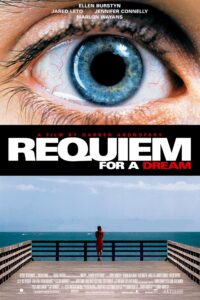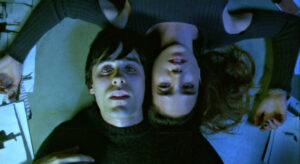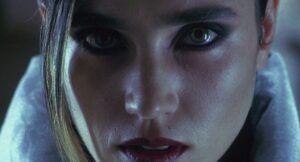“Requiem for a Dream” – Aronofsky’s Mournful Song

Title: “Requiem for a Dream”
Release Date: 2000
Director: Darren Aronofsky
Cast: Ellen Burstyn, Jared Leto, Jennifer Connelly, Marlon Wayans
“Requiem for a Dream” is one of Darren Aronofsky’s most important and striking movies. Here we have an incredibly evocative study of the spiral of addiction, in which a person tries to find a remedy for fear, pain and loneliness. The price for a fleeting moment of happiness turns out to be immensely high. After all, it is impossible to escape from reality, and the relievers of our time only lead to even more suffering. However, the director does not lecture or trivialize, on the contrary, he presents his characters with great empathy and adds pathos to their fate. Here is a tragedy worthy of the title requiem, says Aronofsky, composes a mournful song about human desires and leaves the viewer with an almost tangible scar on their soul.
“Requiem for a Dream” – pills of happiness
Aronofsky’s first big-budget movie “Requiem for a Dream” was based on the 1978 novel by Hubert Selby Jr. The author of the book also created the script for the adaptation. It is the story of several residents of New York: Sarah Goldfarb (Elen Burstyn), her son Harry (Jared Leto) and his girlfriend Marion (Jennifer Connelly) and friend Trone (Marlon Wayans). The film is set over the course of several months, and the main theme is already introduced by the opening scene: Harry and his buddy pawn his mother’s TV to get money for drugs. They soon come up with a lucrative business idea that will allow them to fulfill their dreams: they are going to become drug dealers. Harry wants to invest the money in the boutique of his talented girlfriend, a budding designer.
Meanwhile, Sara receives a phone call informing her that she has been invited to appear on her favorite game show. Performing on TV is her biggest dream, and on this occasion she plans to wear her best red dress, but discovers to her dismay that she no longer fits into it. So, on the advice of a friend, she begins a diet, which is supposed to be helped by special pills. Under the influence of the drugs, Sarah’s obsession with dieting and watching TV begins to worsen. Eventually, the woman descends into madness and ends up in a psychiatric hospital.

“Requiem for a Dream” is a movie characteristic of Aronofsky’s cinema, in which we find significant features of his original poetics. Therefore, the story is told from the extremely subjective perspective of the individual characters, which is emphasized by numerous close-ups of their faces, camera movements reflecting emotional states and sound synchronized with the perception of the characters. Sarah’s deepening madness is thus conveyed by the restless, shaky drives of the image, the deformities of her apartment and the unnatural noises coming to her ears. When Marion, in turn, first gives herself away for money, the camera suggests her increasing dizziness, which culminates in violent vomiting in the pouring rain. Interestingly, the rain constitutes a kind of montage cut in this scene – it brings purification and restores the heroine’s normal perception for a moment.
In contrast, the most significant signal of viewing the world from the character’s perspective is the leitmotiv of the drugs taken. Therefore, the camera accurately captures the few-second moments of taking a sip of a pill, snorting a cannon, and then the physiological reactions to the stimulant: dilated pupils and dilating arteries, in which the blood circulates in an accelerated rhythm. This effect is achieved with great, lightning-fast editing. Aronofsky’s use of such a technique harkens back to the poetics of the music video and advertising of the 1990s – everything happens quickly, and with the help of a few meaningful images he highlights the most important elements of the story.
Of course, it’s hard to overlook the role of phenomenal music in “Requiem for a Dream.” The theme song, one of the most distinctive elements of the film, was composed by Clint Mansell, taking inspiration from mournful themes, especially from the works of Mozart. On screen we hear it performed by the Kronos Quartet. The disturbing, ruefully sad and at the same time pathetic music participates in building the tragic dimension of the characters’ fate. It provides a commentary to the most significant moments of the plot – in the climactic scenes, when the drama of each character is finalized, it resounds with the greatest force. Above all, the music in “Requiem for a Dream” elevates the fate of the characters, brings out their individual biographies from the depths of urban darkness and gives them a unique meaning. Weak, drug-addicted, love-thirsty characters become protagonists of a real tragedy, which is worth paying attention to.

The film “Requiem for a Dream” – a modern tragedy in three acts
Aronofsky openly refers to the pattern of ancient tragedy, dividing the film into three parts: “Summer,” “Autumn” and “Winter.” In the process of unfolding the story, we have a growing crisis, darkening tones of cinematography and deepening drama of the story. The characters begin to realize their wrong choices, but it is too late to turn back from the path they have taken. Reality seeps into the drug-induced trance with redoubled force and they must face their downfall. “Requiem for a Dream,” however, not only shows the various forms of addiction, but also makes a kind of diagnosis of modern times.
For the choice of the protagonists, in a sense, is apparent and, as it were, is made for them. They function in a culture that itself produces successive unreal desires (fame, wealth, success) and immediately offers means to relieve the pain resulting from their unfulfillment. Indeed, the title “dream,” as the director himself pointed out, also refers to this plane: “In the US, we have another drug – the American Dream – the myth of success and fulfillment of dreams. There is also a high price to pay for the disappointment of this myth.”
This directing of attention not only to the effects, but also to the causes of the characters’ situation is very clear in “Requiem for a Dream.” It is noteworthy that Sarah does not become addicted to drugs of her own accord, but becomes a victim of a mindlessly administered medical treatment. The miracle pill for everything, leading to another addiction, is a telling symbol of a closed circle from which there is no way out. It’s a world that generates in people a constant sense of inadequacy, a conviction that they are never good enough, adequately attractive and don’t have as much money as they should. As a result, a woman with a quite successful life, health, son and friends experiences a constant feeling that this is not enough. That she has to look and behave like characters from television, who, if they were to find their way into her ordinary home, would certainly find it repugnant.

“Requiem for a Dream” – death
“Dream” is therefore in Aronofsky’s film a dream, a culturally generated unmatched myth of success, but also a dream and finally death. Significant in this regard is the film’s ending, when all the characters lay down to sleep in an embryonic position, associated with a primal, unconditional sense of security and happiness. Before they do, each of them sees what they dream about for the last time, while Harry dreams about Marion. Nevertheless, it’s a dream that doesn’t end well, with the image of death appearing in it – an eternal dream from which one can no longer return.
Literature:
I.Sulka, „Darren Aronofsky – destrukcja marzeń, dekonstrukcja formy”, [w:] „Mistrzowie kina amerykańskiego. Współczesność”, pod red. Ł. A. Plesnara i R. Syski, Kraków 2010.
